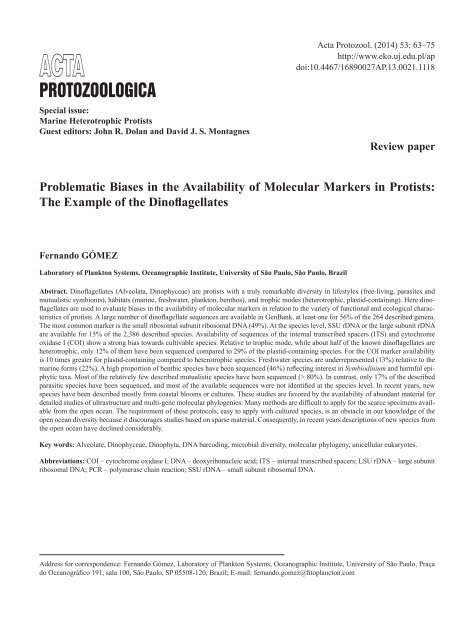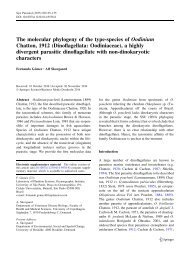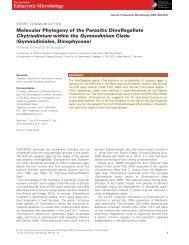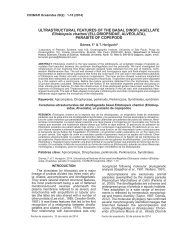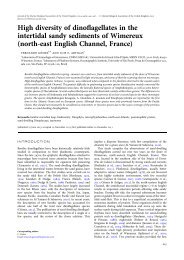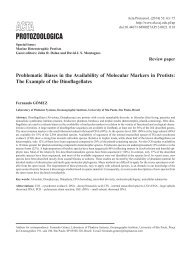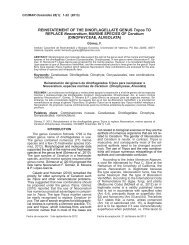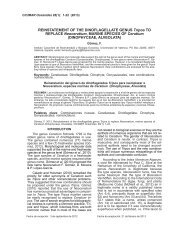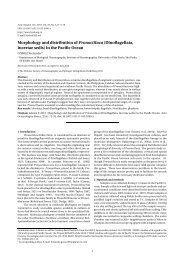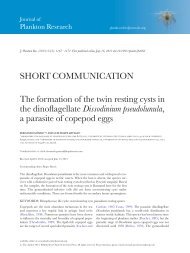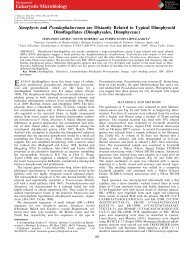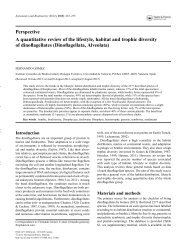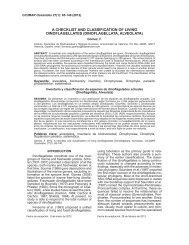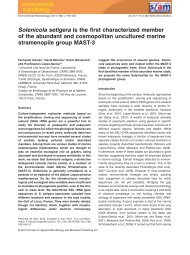ACTA
Create successful ePaper yourself
Turn your PDF publications into a flip-book with our unique Google optimized e-Paper software.
<strong>ACTA</strong><br />
PROTOZOOLOGICA<br />
Special issue:<br />
Marine Heterotrophic Protists<br />
Guest editors: John R. Dolan and David J. S. Montagnes<br />
Acta Protozool. (2014) 53: 63–75<br />
http://www.eko.uj.edu.pl/ap<br />
doi:10.4467/16890027AP.13.0021.1118<br />
Review paper<br />
Problematic Biases in the Availability of Molecular Markers in Protists:<br />
The Example of the Dinoflagellates<br />
Fernando GÓMEZ<br />
Laboratory of Plankton Systems, Oceanographic Institute, University of São Paulo, São Paulo, Brazil<br />
Abstract. Dinoflagellates (Alveolata, Dinophyceae) are protists with a truly remarkable diversity in lifestyles (free-living, parasites and<br />
mutualistic symbionts), habitats (marine, freshwater, plankton, benthos), and trophic modes (heterotrophic, plastid-containing). Here dinoflagellates<br />
are used to evaluate biases in the availability of molecular markers in relation to the variety of functional and ecological characteristics<br />
of protists. A large number of dinoflagellate sequences are available in GenBank, at least one for 56% of the 264 described genera.<br />
The most common marker is the small ribosomal subunit ribosomal DNA (49%). At the species level, SSU rDNA or the large subunit rDNA<br />
are available for 15% of the 2,386 described species. Availability of sequences of the internal transcribed spacers (ITS) and cytochrome<br />
oxidase I (COI) show a strong bias towards cultivable species. Relative to trophic mode, while about half of the known dinoflagellates are<br />
heterotrophic, only 12% of them have been sequenced compared to 29% of the plastid-containing species. For the COI marker availability<br />
is 10 times greater for plastid-containing compared to heterotrophic species. Freshwater species are underrepresented (13%) relative to the<br />
marine forms (22%). A high proportion of benthic species have been sequenced (46%) reflecting interest in Symbiodinium and harmful epiphytic<br />
taxa. Most of the relatively few described mutualistic species have been sequenced (> 80%). In contrast, only 17% of the described<br />
parasitic species have been sequenced, and most of the available sequences were not identified at the species level. In recent years, new<br />
species have been described mostly from coastal blooms or cultures. These studies are favored by the availability of abundant material for<br />
detailed studies of ultrastructure and multi-gene molecular phylogenies. Many methods are difficult to apply for the scarce specimens available<br />
from the open ocean. The requirement of these protocols, easy to apply with cultured species, is an obstacle in our knowledge of the<br />
open ocean diversity because it discourages studies based on sparse material. Consequently, in recent years descriptions of new species from<br />
the open ocean have declined considerably.<br />
Key words: Alveolate, Dinophyceae, Dinophyta, DNA barcoding, microbial diversity, molecular phylogeny, unicellular eukaryotes.<br />
Abbreviations: COI – cytochrome oxidase I; DNA – deoxyribonucleic acid; ITS – internal transcribed spacers; LSU rDNA – large subunit<br />
ribosomal DNA; PCR – polymerase chain reaction; SSU rDNA – small subunit ribosomal DNA.<br />
Address for correspondence: Fernando Gómez, Laboratory of Plankton Systems, Oceanographic Institute, University of São Paulo, Praça<br />
do Oceanográfico 191, sala 100, São Paulo, SP 05508-120, Brazil; E-mail: fernando.gomez@fitoplancton.com
64<br />
F. Gómez<br />
INTRODUCTION<br />
The use of molecular methods has played a major<br />
role in advancing our understanding of microbial diversity.<br />
The technique of DNA taxonomy or DNA barcoding,<br />
a short standardized stretch of DNA sequence,<br />
may be used to identify species (Blaxter 2004, Miller<br />
2007). The most extended molecular markers in DNA<br />
taxonomy are the mitochondrial markers [cytochrome<br />
oxidase I (COI), cytochrome oxidase B, etc.], and the<br />
nuclear markers of the ribosomal DNA operon. COI is<br />
the most extended marker for the DNA barcoding in animals<br />
(Hebert et al. 2003), and macroalgae (Le Gall and<br />
Saunders 2010), while it is considered too conserved<br />
for higher plants (Newmaster et al. 2006). The utility<br />
of COI for DNA barcoding is controversial in protists,<br />
with less documented attempts and variable success<br />
(Ehara et al. 2000, Evans et al. 2007). It has been pointed<br />
out that a barcoding system based on mitochondrial<br />
markers such as COI or cytochrome oxidase B will not<br />
provide a universal solution to protist identifications<br />
because anaerobic species lack mitochondria (Henze<br />
and Martin 2003).<br />
The other main group of markers for phylogenetical<br />
analysis is the ribosomal DNA operon. These genes are<br />
present throughout the living world and they evolve relatively<br />
slowly, both of these traits enable comparison of<br />
distantly related organisms. The repetitive arrangement<br />
within the genome provides enough amounts of template<br />
DNA for PCR, even in smallest organisms (Hillis<br />
and Dixon 1991). These markers are the 18S rDNA or<br />
small subunit ribosomal DNA (SSU rDNA), the 28S<br />
rDNA or large subunit rDNA (LSU rDNA), the internal<br />
transcribed spacers 1 (ITS1) and 2 (ITS2) regions,<br />
and the 5.8S rDNA. There are other markers used in<br />
molecular phylogenies, mainly based on protein coding<br />
genes: α- and β-tubulin, actin, cytochrome oxidase B,<br />
heat-shock protein 90, and others (Pochon et al. 2012).<br />
These alternative markers are not well represented in<br />
public databases. The vast majority of the sequences<br />
are from photosynthetic strains available in culture<br />
collections and the phylogenies do not include enough<br />
taxa to be widely useful.<br />
The dinoflagellates are an ancient alveolate group<br />
of about ~ 2,400 extant described species and other<br />
~ 2,000 fossil species (Taylor 1987, Gómez 2012a).<br />
Dinoflagellates possess numerous unique morphological<br />
and ultrastructural attributes (Hackett et al. 2004)<br />
such as huge genome sizes of 0.2–200 pg DNA per cell<br />
(LaJeunesse et al. 2005, Lin 2006) and many genes<br />
with high copy numbers (Rowan et al. 1996). This<br />
feature has favored single-cell sequencing (Lynn and<br />
Pinheiro 2009). The single-cell PCR technique allows<br />
sequencing of rare uncultured species, including those<br />
found only in low abundances, from different habitats<br />
and ecological niches.<br />
While the size of the dinoflagellate genome has, to<br />
date, prevented whole genome sequencing projects,<br />
several genes have been sequenced. The first sequence<br />
of a dinoflagellate gene was the 5S rDNA of Crypthecodinium<br />
cohnii (Hinnebusch et al. 1981). The most<br />
extensive markers are parts of the rDNA array, the SSU<br />
rDNA (McNally et al. 1994, Saunders et al. 1997), LSU<br />
rDNA (Lenaers et al. 1991, Daugbjerg et al. 2000), and<br />
the ITS regions (LaJeunesse 2001). The differences in<br />
the evolutionary rates in the ribosomal genes of dinoflagellates,<br />
especially SSU rDNA and also in the domains<br />
of the LSU rDNA, has yielded phylogenetic trees<br />
with a characteristic structure: a large group of short<br />
branched sequences, the so-called Gymnodiniales, Prorocentrales<br />
and Peridiniales complex (GPP complex),<br />
and a group with longer branches including Gonyaulacales<br />
and other taxa (Saunders et al. 1997, Saldarriaga<br />
et al. 2004).<br />
The phylogenies based on SSU and LSU rDNA<br />
markers do not resolve the relations between the main<br />
classical orders due to extremely low divergence rates.<br />
As a general rule, the SSU rDNA marker tends to be suitable<br />
to infer phylogenies at family or genus level while<br />
the LSU rDNA marker is more effective in discriminating<br />
species. The ITS marker is present in multiple distinct<br />
copies, with the possibility that high intra- and intergenomic<br />
variation and the presence of indels that can<br />
make direct sequencing challenging and alignment difficult.<br />
It is really difficult to design a dinoflagellate-specific<br />
primer set to amplify the ITS region for all or most<br />
of the dinoflagellate taxa (Litaker et al. 2007, Pochon et<br />
al. 2012, Stern et al. 2012). The COI marker can be useful<br />
for identifying single cells or monospecific cultures<br />
and successfully used to distinguish different genotypes<br />
of the coral symbiont Symbiodinium (Takabayashi et al.<br />
2004). However, its utility as a dinoflagellate barcode<br />
is questionable due to repetitive failure of the primer<br />
sets to amplify all dinoflagellate species in natural assemblages,<br />
and the lower resolving power with generally<br />
lower bootstrap support than other genes examined<br />
(Zhang et al. 2007, Lin et al. 2009). Plastid genes have<br />
not been used to infer the phylogeny of dinoflagellates
Molecular Markers in Dinoflagellata<br />
65<br />
for several reasons. For example, they are only present<br />
in about 50% of taxa, and in those species, they may<br />
have been lost and gained on multiple occasions (Saldarriaga<br />
et al. 2001, Hackett et al. 2004).<br />
Dinoflagellates exhibit extreme diversity in almost<br />
all ecological characteristics, including their modes of<br />
nutrition (heterotrophic, plastid-containing), habitat<br />
distribution (marine, freshwater, plankton, benthos),<br />
and lifestyle (free-living species, parasites and mutualistic<br />
symbionts) (Taylor 1987, Gómez 2012b). For<br />
these reasons, dinoflagellates are an ideal case to evaluate<br />
biases in the availability of the molecular markers in<br />
relation to functional and ecological characteristics of<br />
protist taxa. It appears that the advances in the molecular<br />
phylogeny show a high taxonomic selectivity, and<br />
may even have adverse consequences for the knowledge<br />
of certain groups.<br />
MATERIALS AND METHODS<br />
The primary source used was the checklist of living dinoflagellates<br />
by Gómez (2012a) that listed 2,377 described species. Twelve<br />
other species have been added (recently described or missing in<br />
the previous checklist). Each species was classified with regard to<br />
distribution and habitat (marine or freshwater, and planktonic or<br />
benthic), lifestyle (free-living, parasitic or mutualistic symbionts)<br />
as well as trophic modes (heterotrophic or plastid-containing) following<br />
the criteria reported in Gómez (2012b). The taxa identified<br />
at the species level (binomials) were surveyed in international nucleotide<br />
sequence databases (DDBJ/EMBL/GenBank), and labeled<br />
according to the availability of at least one nucleotide sequence of<br />
the most extensive molecular markers (SSU, LSU, ITS and COI).<br />
The database is provided as supplementary material (supplementary<br />
material Table S1). The alternative molecular markers (actin, α- and<br />
β-tubulin, cytochrome oxidase B, heat-shock protein 90, etc.) were<br />
largely underrepresented, and the vast majority of the sequences<br />
were from photosynthetic strains available in culture collections.<br />
Almost all the species names reported in GenBank were represented<br />
by at least one nucleotide sequence of the SSU, LSU, ITS or COI<br />
markers, while the only binomials lacking any of these markers<br />
were Symbiodinium fittii (only microsatellite sequence available),<br />
Prorocentrum nanum (only cytochrome oxidase B), and Pyrocystis<br />
fusiformis (only luciferase).<br />
It is often difficult to determinate whether the binomials reported<br />
in GenBank were correctly identified. There is no formal<br />
documentation of taxonomic identifications (e.g. photographs, collection<br />
sources for cultures, or information on the individual who<br />
performed identifications). Some sequences of other groups are erroneously<br />
reported under dinoflagellate names [Exuviaella pusilla<br />
(#DQ388459) or Prorocentrum minimum (#EF017804)]. It can be<br />
assumed that the cultures were contaminated, and the authors did not<br />
first check the BLAST (Basic Local Alignment Search Tool) entries<br />
of their sequences. For example, a sequence of Neoceratium furca<br />
(#AY027908) corresponds with an Alexandrium species. In addition<br />
to contaminations, culture collections are sometimes subjected<br />
to mislabeling or misidentifications. For example sequences of the<br />
armoured genus Heterocapsa were named under the unarmoured<br />
genus Gymnodinium [#Gymnodinium sp. CCMP424 (#EF492492)<br />
or Gymnodinium sp. UTEX1653 (#EF492494)] (see additional examples<br />
in Stern et al. 2012). According to GenBank the sequence<br />
of Peridinium centenniale was restricted to the cytochrome oxidase<br />
B gene. The SSU rDNA sequences of this species may be under<br />
other names [Dinophyceae sp. CCAC0002 (#EF058236), Glenodinium<br />
inaequale (#EF058237)]. There were sequences from cultures<br />
identified as ‘Scrippsiella inulfa’ that may correspond to Calcigonellum<br />
infula. The misspelling of the epithet did not facilitate<br />
the identification of the correct species name. In other cases, there<br />
is no documentation to resolve doubts. The epithets of ‘Prorocentrum<br />
donggang’ or ‘P. tainan’ resemble valid binomials. However,<br />
these species have not been formally described and the apparent<br />
epithet may refer to places where the cells were isolated in Taiwan.<br />
‘Gymnodinium falcatum’ (#AY320049) has been never formally<br />
described. It may refer to Gyrodinium faltacum. The species<br />
is named Pseliodinium vaubanii, one of its synonyms, because the<br />
morphology and the sequence did not branch with Gymnodinium or<br />
Gyrodinium sensu stricto. These are examples of the difficulties to<br />
assign a proper species name to the sequences.<br />
RESULTS<br />
Overview of the availability of the main molecular<br />
markers<br />
To date, for the 264 described extant genera, at least<br />
one nucleotide sequence is available in GenBank for<br />
149 (56%) of dinoflagellate genera (Table 1). The most<br />
common marker is SSU rDNA for 131 genera (49%),<br />
LSU rDNA for 108 genera (41%), ITS for 69 genera<br />
(26%), and COI for 48 genera (18%). At least one nucleotide<br />
sequence identified at the species level is available<br />
for 493 dinoflagellates (Table 1). This corresponded<br />
to 20% of the 2,386 extant described species. The<br />
SSU rDNA marker is available for 345 species (14% of<br />
2,386), LSU for 358 species (15%), ITS for 184 species<br />
(7%), and COI for 97 species (4%).<br />
Among the most speciose dinoflagellate genera<br />
(> 11 species per genus), the highest percentage of<br />
sequenced species concerns Gambierdiscus (100%),<br />
Symbiodinium (87%, only lacking S. tridacnorum), and<br />
Alexandrium (77%), followed by other marine plastid-containing<br />
genera such as Karenia, Karlodinium,<br />
Blastodinium, Heterocapsa, Prorocentrum and Scrippsiella,<br />
with sequences of more than 40% of the species<br />
(Fig. 1). All these taxa are available in culture, with<br />
the exception of the parasite Blastodinium. The genus
66<br />
F. Gómez<br />
Table 1. Number and percentage of dinoflagellate genera and species with at least one nucleotide sequence available in DDBJ/EMBL/<br />
GenBank in January 2013. SSU – small subunit rDNA, LSU – large subunit rDNA, ITS – internal transcribed spacers, COI – cytochrome<br />
oxidase I, CHL – plastid-containing, HET – heterotrophic, FRE – free-living, PAR – parasite, SYM – mutualistic symbiont, MAR – marine,<br />
FS – freshwater/ continental, PLK – plankton, BEN – benthos.<br />
Total Any marker SSU LSU ITS COI<br />
Genera 264 149 (56%) 131 (49%) 108 (41%) 69 (26%) 48 (18%)<br />
Species 2,386 493 (20%) 345 (14%) 358 (15%) 184 (7%) 97 (4%)<br />
CHL 1,204 348 (29%) 237 (20%) 269 (22%) 161 (13%) 89 (7%)<br />
HET 1,182 145 (12%) 108 (10%) 89 (7%) 23 (2%) 8 (0.7%)<br />
FRE 2,200 447 (20%) 307 (14%) 331 (15%) 156 (7%) 91 (4%)<br />
PAR 165 29 (17%) 29 (17%) 18 (11%) 18 (11%) 1 (0.6%)<br />
SYM 21 17 (81%) 9 (43%) 9 (43%) 10 (47%) 5 (24%)<br />
MAR 1,964 438 (22%) 305 (15%) 310 (16%) 163 (8%) 93 (5%)<br />
FW 422 55 (13%) 40 (9%) 48 (11%) 21 (5%) 4 (0.9%)<br />
PLK 2,180 397 (18%) 277 (13%) 301 (14%) 154 (7%) 81 (3%)<br />
BEN 206 96 (46%) 68 (33%) 57 (27%) 30 (14%) 16 (7%)<br />
with the highest number of sequenced species, 28, is<br />
Neoceratium (Fig. 1). The percentage of sequenced<br />
species ranged from 5–8% among the most speciose<br />
genera (Protoperidinium, 268 species; Gymnodinium,<br />
216 species; Gyrodinium, 153 species). There are no<br />
sequences labeled with a proper species name for the<br />
speciose genera Warnowia, Oxytoxum, Lissodinium,<br />
Centrodinium or Corythodinium (Fig. 1). The genus Dinophysis<br />
comprises both plastid-containing and heterotrophic<br />
species. Dinophysis sensu lato is the genus with<br />
the higher number of sequenced heterotrophic species.<br />
Sequences of eight heterotrophic species of the Dinophysis<br />
hastata-group and other six heterotrophic species<br />
of other clades (D. apicata, D. argus, D. braarudii,<br />
D. brevisulcus, D. expulsa, D. similis) are available in<br />
GenBank (supplementary material Table S1). The exclusively<br />
heterotrophic genus with the higher number<br />
of sequenced species is Ornithocercus (6 of the 15 described<br />
species, 40%). No sequences are available for<br />
Glenodinium, the most speciose freshwater genus (the<br />
sequence labeled Glenodinium inaequale corresponded<br />
to other genus). The speciose freshwater genus with the<br />
higher percentage of sequenced species is Peridinium<br />
(36%), while only one species is sequenced for the genera<br />
Cystodinium and Peridiniopsis (Fig. 1).<br />
There are only 59 species of the 2,386 described<br />
species (2%) with all of the four main markers (SSU,<br />
LSU, ITS, COI) available in GenBank. These species<br />
belong to the genera responsible for harmful algal<br />
blooms such as Prorocentrum (11 species), Alexandrium<br />
(9 species), and Dinophysis (5 species). There<br />
is not any representative of a parasitic form. The ‘wellsequenced’<br />
group is largely dominated by plastid-containing<br />
species, with only seven heterotrophic species:<br />
Crypthecodinium, Noctiluca, Oxyrrhis, three pfiesterid<br />
species (Cryptoperidiniopsis, Pfiesteria, Pseudopfiesteria),<br />
and Phalacroma rotundatum. All the species with<br />
the four main markers are planktonic, with the exception<br />
of seven species of symbiotic Symbiodinium, and<br />
epiphytic species of Prorocentrum and Coolia monotis.<br />
The only freshwater species with the four main markers<br />
are Parvodinium inconspicuum and Peridinium willei.<br />
The SSU rDNA marker is the only available for<br />
111 species, with 53 heterotrophic species (48% heterotrophic<br />
species). The LSU rDNA marker alone is<br />
available for 95 species, with 36 heterotrophic species<br />
(38%). The ITS marker is the only sequence for 14 species,<br />
mainly the genera Scrippsiella (5 species) and<br />
Heterocapsa (3 species). These are plastid-containing<br />
species, with the exception of ITS sequence of Protoperidinium<br />
tricingulatum (supplementary material Table<br />
S1). The COI marker is the only molecular marker<br />
for three species, the plastid-containing Neoceratium<br />
macroceros, Gonyaulax hyalina and Prorocentrum pusillum<br />
(the SSU rDNA sequence of the latter did not<br />
correspond to a dinoflagellate).
Molecular Markers in Dinoflagellata<br />
67<br />
100<br />
90<br />
80<br />
268 spp.<br />
216 spp.<br />
153 spp.<br />
# number of species<br />
70<br />
60<br />
50<br />
40<br />
30<br />
20<br />
10<br />
Protoperidinium<br />
Gymnodinium<br />
Gyrodinium<br />
Amphidinium<br />
Neoceratium<br />
Gonyaulax<br />
Phalacroma<br />
Glenodinium<br />
Dinophysis s. s.<br />
Histioneis<br />
Heterodinium<br />
Oxytoxum<br />
Amphisolenia<br />
Prorocentrum (Haplodinium)<br />
Peridinium s. s.<br />
Katodinium<br />
Warnowia<br />
Prorocentrum s. s.<br />
Alexandrium<br />
Cochlodinium s. s.<br />
Scrippsiella<br />
Heterocapsa<br />
Lissodinium<br />
Centrodinium<br />
Hemidinium<br />
Symbiodinium<br />
Cochlodinium (with plastids)<br />
Peridiniopsis<br />
Amphidiniopsis<br />
Corythrodinium<br />
Ornithocercus<br />
Haplozoon<br />
Cystodinium<br />
Karenia<br />
Karlodinium<br />
Parahistioneis<br />
Blastodinium<br />
Pyrocystis<br />
Gambierdiscus<br />
0<br />
More speciose dinoflagellate genera<br />
Fig. 1. Number of species of the most speciose dinoflagellate genera (> 11 species per genus). The empty bars represented the number of<br />
described species based on Gómez (2012a). The black bars represent the number of species with, at least, one nucleotide sequence available<br />
in DDBJ/EMBL/GenBank in January 2013.<br />
Sequences by habitat<br />
From marine waters a total of 1,964 dinoflagellate<br />
species (82% of the total 2,386 species) have been described<br />
compared to 422 species (18%) from freshwater<br />
environments. Of the described 1,964 marine species,<br />
there is at least one sequence for 438 species or<br />
22% (Table 1). SSU rDNA sequences are available for<br />
305 species (15% of the total marine species), LSU for<br />
310 species (16%), ITS for 163 species (8%), and COI<br />
for 93 species (4%).<br />
A total of 55 species of the 422 freshwater species<br />
(13%) have been sequenced for at least one molecular<br />
marker. The SSU marker is available for 40 species<br />
(9%), LSU for 48 species (11%), and ITS for 21 species<br />
(5%). COI sequences are only available for four freshwater<br />
species (< 1%, Ceratium hirundinella, Parvodinium<br />
inconspicuum, Peridinium willei and Piscinoodinium<br />
limneticum). The percentage of heterotrophic<br />
species described from freshwaters is low (11%). Only<br />
the sequences of two heterotrophic species, Gyrodinium<br />
helveticum and Tyrannodinium edax, are available<br />
in GenBank (supplementary material Table S1).<br />
Most of the described dinoflagellate species are<br />
planktonic, 91% of the total 2,386 species, with only<br />
204 (9%) of the species benthic. With regard to sequences,<br />
there is at least one nucleotide sequence for<br />
399 plankton species (18%, Table 1). An SSU rDNA<br />
sequence is available for 279 species (13%), LSU for<br />
301 species (14%), ITS for 154 species (7%), and COI<br />
for 81 species (3%). For the 204 benthic species, there<br />
are sequences for 94 species (46%). This relative overrepresentation<br />
is due to the numerous studies on Symbiodinium,<br />
and the harmful epiphytic species of Prorocentrum<br />
(20 species), Gambierdiscus (11 species),<br />
Ostreopsis (4 species) and Coolia (3 species). The SSU<br />
rDNA was the most common marker (66 species, 32%),<br />
followed by the LSU rDNA (57 species, 28%), ITS (30<br />
species, 14%), and COI (16 species, 8%).
68<br />
F. Gómez<br />
Sequences by trophic mode<br />
Among described dinoflagellate species 49%<br />
(1,182 species) are purely heterotrophic, devoid of<br />
plastids, while 51% of the dinoflagellate species have<br />
been reported to contain plastids (that does not strictly<br />
imply autotrophy). In GenBank there are 493 species<br />
with at least one sequence (Table 1) and of these<br />
species only 145 species (29%) were heterotrophic.<br />
This bias towards plastid-containing species varies<br />
according to the markers. The SSU rDNA marker is<br />
available for 345 species, 107 of which (31%) are heterotrophic.<br />
The LSU rDNA sequence is available for<br />
358 species, with 89 heterotrophic species (24%). The<br />
ITS sequence is available for 184 species, including<br />
23 heterotrophic species (12%). The COI sequence,<br />
available for 97 species includes only 8 heterotrophic<br />
species (Table 1).<br />
Sequences by lifestyle<br />
Overall the species catalogue of dinoflagellates is<br />
largely dominated by free-living forms (2,200 species,<br />
92%). There are relatively few parasitic species (165<br />
species, 7%), or mutualistic symbionts (21 species,<br />
< 1%). Of the 2,200 free-living species, 477 species<br />
(22%) are represented by at least one molecular marker.<br />
The SSU marker is available for 307 free-living species<br />
(14%), 331 species for LSU (15%), 156 species for ITS<br />
(7%), and 91 species for COI (4%, Table 1).<br />
For the 165 parasitic species, there are 29 species<br />
(17%) with at least one available sequence. The best sequenced<br />
genus is Blastodinium with 11 sequenced species.<br />
The SSU rDNA sequence was available for all the<br />
parasitic species represented in GenBank (29 species,<br />
17% of the 165 parasites). LSU rDNA sequences were<br />
available for 18 species (11%), and ITS for 18 species<br />
(11%). Only one sequence of the COI marker is available<br />
(0.6%, Piscinoodinium limneticum).<br />
From the 21 mutualistic symbiotic species, there are<br />
sequences available for 17 species (80%). Most of them<br />
belong to the genus Symbiodinium. The only taxa lacking<br />
nucleotide sequences were Scrippsiella velellae,<br />
Endodinium chattonii, Symbiodinium tridacnorum and<br />
S. fittii; the latter with only a microsatellite sequence<br />
available (supplementary material Table S1). For the 21<br />
species of mutualistic symbionts, the ribosomal markers<br />
(SSU, LSU, ITS) are available for 9–10 species<br />
each one, and COI sequences were available for five<br />
species (Symbiodinium and Pelagodinium).<br />
DISCUSSION<br />
Habitat bias<br />
Differences between marine and freshwater species<br />
Most dinoflagellate species inhabit marine waters<br />
and only 17% of the described species are found in<br />
freshwater environments. The freshwater dinoflagellates<br />
are highly dominated by plastid-containing species<br />
(88%), while in marine environments there is a slight<br />
dominance of heterotrophic species (58%) (Gómez<br />
2012b). Consequently, it is easier to establish cultures<br />
and to obtain sequences of freshwater species. Overall,<br />
the freshwater habitats are usually more accessible and<br />
require fewer infrastructures for sampling when compared<br />
to open ocean areas. For these reasons, we can<br />
expect a higher representation of the freshwater species<br />
in the nucleotide databases. However, the percentage of<br />
sequenced freshwater species (13%) was lower than for<br />
the marine species (22%, Table 1). In part, the marine<br />
species are favored by interest in the marine harmful<br />
algal blooms (Alexandrium, Dinophysis, Gambierdiscus,<br />
etc.). However, the low percentage of sequenced<br />
species from freshwaters could also be related an overestimation<br />
of freshwater species richness (Thessen et<br />
al. 2012).<br />
The accessibility of freshwater species favors species<br />
descriptions from occasional samplings in ponds, lakes<br />
or reservoirs near laboratories. The species descriptions<br />
are often too poor to allow the organism to be re-identified<br />
and the descriptions in a highly dispersed literature,<br />
often apparently unknown to other researchers. For<br />
example, Cystodinium cornifax, Gymnodinium uberrimum,<br />
Prosoaulax lacustris (= Amphidinium lacustre)<br />
or Woloszynskia pascheri have been described under<br />
more than ten heterotypic synonyms. An overestimation<br />
of species is more evident for the unarmored genera.<br />
The descriptions are often based on distorted cells<br />
due to the preservation treatment or live specimens that<br />
were stressed or moribund. Under Gymnodinium, Gyrodinium,<br />
Amphidinium and Katodinium have been pooled<br />
species from different phylogenetic origins. Since Daugbjerg<br />
et al. (2000), the spliting of these unarmoured genera<br />
has begun based on molecular data. A critical study<br />
is required to assess the disproportionate number of new<br />
species described by some authors (Schiller, Skvortzov,<br />
van Meel, Baumestier, Conrad, Christen, Harris, Campbell,<br />
Okolodkov). The description of new species using<br />
previously occupied names by Skvortzov, Christen, van
Molecular Markers in Dinoflagellata<br />
69<br />
Meel or Campbell is evidence that these authors did not<br />
check all the existing literature. Thessen et al. (2012) reported<br />
that 38% of the species of Gymnodinium as ‘oncers’,<br />
not ever observed since their original description.<br />
Within the context of paucity of skilled taxonomists associated<br />
with the sequencing projects, an excess of poor<br />
quality species descriptions do not facilitate the identification<br />
at the species level. Thessen et al. (2012) reported<br />
that there are 250 sequences in GenBank that referred<br />
to Gymnodinium, but only 86 (30%) are labeled with<br />
a proper species name.<br />
The freshwater thecate genera Cystodinium and<br />
Hemidinium contain an anomalously high number of<br />
species described by Baumeister (1957) and Skvortzov<br />
(1958, 1968), respectively. The genus Glenodinium is<br />
plagued with poor species descriptions, mainly described<br />
by Skvortzov (1958, 1968) and Schiller (1955). We can<br />
hypothesize two explanations, perhaps not mutually exclusive:<br />
A) these authors are good examples of splitter<br />
taxonomists, ignoring intraspecific variability and/or the<br />
previous species descriptions, or B) these authors were<br />
right and there is a considerable diversity and degree of<br />
endemism of dinoflagellate in freshwater environments.<br />
Considering the first hypothesis – for authors such<br />
as Skvortzov – we can speculate that lack of access to<br />
all the scientific literature may have hindered appropriate<br />
discrimination among species. This is not the case<br />
of Schiller who authored a complete monograph on<br />
marine and freshwater dinoflagellates (Schiller 1937).<br />
It is difficult to evaluate whether their new species correspond<br />
to known species due to the scarce detail of<br />
the line drawings, especially for unarmored dinoflagellates.<br />
Gonyaulax, Prorocentrum or Dinophysis are well<br />
investigated as responsible for harmful proliferations<br />
and these thecate genera are less susceptible to cell<br />
shape changes. Schiller described species of Gonyaulax<br />
(G. grabrielae, G. matkovicii) that are only known from<br />
the original description. Most of the species of Prorocentrum<br />
and Dinophysis described by Schiller have<br />
been synonymized (Gómez 2012a). The observations of<br />
other Dinophysis species (i.e. D. biceras) are restricted<br />
to Schiller’s description. This is highly unusual because<br />
Schiller described these species from areas of the coastal<br />
Mediterranean Sea (Gulf of Trieste, Naples) that has<br />
been intensively investigated. This suggests that many<br />
of the species described by Schiller were life stages of<br />
known species, teratogenical or damaged specimens.<br />
The other alternative is to consider that these authors<br />
were right. There is a high diversity of dinoflagellates<br />
in freshwater environments, and their observations are<br />
evidence of a high degree of endemism because the taxa<br />
have not been observed in other places. The fact is that<br />
there are very few well documented examples of endemic<br />
dinoflagellates in freshwater environments (Annenkova<br />
et al. 2011). Environmental sequencing surveys have<br />
revealed a large diversity of dinoflagellates in marine<br />
waters, while the abundance and diversity of clades is<br />
considerably lower in freshwater environments (Slapeta<br />
et al. 2005, Richards et al. 2005, Lefèvre et al. 2008). Microscopical<br />
observations suggest a relatively low number<br />
of dinoflagellate lineages in freshwater environments.<br />
For example, members of the order Dinophysales are<br />
absent in freshwaters, while they reach a high diversity<br />
in marine waters (Hastrup Jensen and Daugbjerg 2009,<br />
Gómez et al. 2011). Gonyaulacales or Prorocentrales<br />
are scarcely represented in freshwaters (Logares et al.<br />
2007). Ceratium is restricted to few freshwater species,<br />
while the marine relatives reach a high diversity (Gómez<br />
et al. 2010a). Basal dinoflagellates such as Syndiniales<br />
are abundant and genetically diverse in marine waters,<br />
but they are unknown in freshwater environments (Guillou<br />
et al. 2008). Schiller (1955) described several tens<br />
of new dinoflagellates from an Alpine lake, while more<br />
recent studies from 27 Alpine lakes found only a total of<br />
34 dinoflagellates species (Hansen and Flaim 2007). For<br />
these reasons, it is more plausible to consider that the low<br />
percentage of sequenced freshwater species is largely influenced<br />
by an overestimation of species richness due to<br />
the activity of ‘splitters’.<br />
Acquiring material from the open sea usually requires<br />
more infrastructures than that needed for sampling<br />
in freshwater environments. Samples from the<br />
classical ocean expeditions were analyzed by skilled<br />
taxonomists (Kofoid, Jørgensen, Paulsen, Pavillard,<br />
etc.). The results were published in monographs or reports<br />
of scientific expeditions. This avoids the species<br />
re-descriptions due to previous records appearing only<br />
in many separate and difficult to access publications.<br />
Despite this, the phenomenon of a likely overestimation<br />
of species richness is not restricted to freshwater<br />
habitats. The most speciose dinoflagellate genus, Protoperidinium,<br />
contains 269 marine species that are easy<br />
to collect by net sampling and they are relatively wellpreserved.<br />
The available sequences are restricted to 24<br />
species that represent but 9% of the described species<br />
(Yamaguchi et al. 2006, Gribble and Anderson 2006).<br />
Numerous species described by Böhm, Gaarder, Mangin,<br />
Matzenauer, Meunier, Schiller and Wailes have<br />
been scarcely ever reported by other authors. Balech<br />
and Abé also described numerous species with detailed
70<br />
F. Gómez<br />
studies of the tabulation. None of the species described<br />
by these authors has been sequenced (Protoperidinium<br />
thulesense and P. steidingerae are new names for previously<br />
known species). The exclusion of these doubtful<br />
species will provide more realistic values of the percentage<br />
of sequenced species.<br />
The lack of sequences identified at the species level<br />
may be related to the difficulties in recognizing species<br />
during the isolation under the microscope. For<br />
example, Carbonell-Moore described twenty-five species<br />
and three genera of the family Podolampadaceae<br />
based on diagnostic characters that are only visible using<br />
scanning electron microscopy (Carbonell-Moore<br />
1994). These species are present in low abundance in<br />
the under sampled warm waters of the open ocean. The<br />
diagnostic morphological characters used for species<br />
delimitation, even genera, are not easily discernible under<br />
light microscopy. These cells resemble small transparent<br />
‘balls’, and the sequenced specimens are pooled<br />
as Blepharocysta sp. (Gómez et al. 2010b).<br />
Takano and Horiguchi (2006) published an article entitled<br />
‘Acquiring scanning electron microscopical, light<br />
microscopical and multiple gene sequence data from<br />
a single dinoflagellate cell’. These authors concluded:<br />
‘This technique can be applied to both photosynthetic<br />
and heterotrophic dinoflagellates and will accelerate<br />
biodiversity studies’. According to this technique, a single<br />
dinoflagellate cell is fixed (Lugol, glutaraldehyde),<br />
postfixed (osmium tetroxide), followed by an alcohol<br />
dehydration series, critical point drying, sputter coating,<br />
vacuum, electron radiation, and later the DNA is<br />
extracted from the single cell to get sequences for several<br />
molecular markers. Many holotypes deposited in<br />
scanning electron microscopy stubs of museums could<br />
theoretically benefit from this technique. However, neither<br />
Takano and Horiguchi (2006) nor any author(s)<br />
have ever successfully applied this technique to a single<br />
cell from a natural sample. However, as a consequence<br />
of such reports purporting that a single cell can yield<br />
a wealth of data, studies of rare open ocean dinoflagellates<br />
can be easily rejected by critical reviewers using<br />
the false argument that one can easily obtain several<br />
different molecular markers and images using scanning<br />
electron microscopy from a single cell.<br />
Differences between plankton and benthic species<br />
Dinoflagellates are dominated by planktonic species,<br />
while benthic forms represent but 8% of the total species<br />
(Gómez et al. 2012b). The type of habitat, plankton<br />
or benthos, has also an influence on the availability of<br />
molecular markers. At least one sequence is available<br />
for 18% of the plankton species, while the percentage<br />
increases to 46% for the benthic species (Table 1).<br />
Several harmful groups (the epiphytes Prorocentrum,<br />
Gambierdiscus, Ostreopsis, Coolia and some species<br />
of Amphidinium), and the symbiont Symbiodinium are<br />
significant constituents of the sequenced species. With<br />
the exception of some insufficiently known freshwater<br />
benthic genera (Cystodinium, Stylodinium, Tetradinium),<br />
the benthic forms appear to be wellrepresented<br />
in GenBank compared to planktonic species.<br />
In the earlier taxonomical studies, the descriptions<br />
of benthic species were sporadic (i.e. Prorocentrum<br />
lima), and often from accidental observations of resuspended<br />
material. Epiphytic dinoflagellates began to<br />
receive attention after Fukuyo in late 1970’s, and Faust<br />
described numerous species in the 1990’s. After a few<br />
pioneering studies on sand-dwelling dinoflagellates<br />
(Herdman, Balech), the number of genera and species<br />
has largely increased in the last years (Dodge, Hoppenrath,<br />
Horiguchi, Murray, Selina, Yoshimatsu). The sampling<br />
coverage of benthic species is nearly restricted to<br />
shallow waters as epiphytes of macrophytes, coral reefs<br />
or sandy beaches. Environmental sequencing surveys<br />
in deep ocean sediments reveal an unknown diversity<br />
of benthic dinoflagellates (López-García et al. 2007).<br />
Differences with trophic mode<br />
One half of the species of dinoflagellates described<br />
are heterotrophic (Gómez 2012b). However, while<br />
about 29% of the plastid-containing species have at<br />
least one sequence available, the figure is but 12% for<br />
heterotrophic species (Table 1). Fortunately, sequences<br />
of the SSU and LSU rDNA markers can be obtained<br />
from single cells that facilitate investigation of uncultivable<br />
species (Lynn and Pinheiro 2009). For other alternative<br />
markers, the bias continues towards the photosynthetic<br />
species available in cultures. For the COI<br />
marker, the number of sequenced plastid-containing<br />
species is 10 times greater than for the heterotrophic<br />
ones. Each time that a new molecular marker is presented<br />
as the ideal barcode marker, it is tested with the<br />
species available in cultures (Stern et al. 2012). These<br />
species constitute less than 10% of described species,<br />
and they do not represent the functional and ecological<br />
diversity of the dinoflagellates.<br />
Difference with lifestyle<br />
Relative representation in sequence availability also<br />
varies with dinoflagellate lifestyle. The relatively few
Molecular Markers in Dinoflagellata<br />
71<br />
described symbiotic dinoflagellates associated with<br />
coral reefs such as Symbiodinium have received considerable<br />
attention (LaJeunesse et al. 2001, Pochon<br />
et al. 2012). Symbiodinium displays considerable genetic<br />
diversity, which suggests a high number of undescribed<br />
species (McNally et al. 1994). The diversity<br />
of mutualistic symbiotic dinoflagellates associated with<br />
planktonic Rhizaria (Acantharia, Foraminifera and Radiolaria)<br />
remains underestimated (Siano et al. 2010,<br />
Anderson 2014).<br />
A total of 165 dinoflagellates species have been described<br />
as parasites (7%). The dinokaryotic parasites<br />
(86 species) are usually identified to the species level<br />
in the molecular studies (Coats et al. 2010, Gómez et<br />
al. 2009), and especially for Blastodinium (Skovgaard<br />
et al. 2012, Skovgaard 2014). The diversity of the basal<br />
dinoflagellates (79 species) is probably largely underestimated.<br />
Most of the sequences of basal parasitic<br />
dinoflagellates (Amoebophrya, Euduboscquella, Hematodinium,<br />
Ichthyodinium and Syndinium) have not<br />
been not identified to the species level (Guillou et al.<br />
2008). Furthermore, the epithets of numerous parasitic<br />
forms are based on the host names such as Amoebophrya<br />
cerati, A. leptodisci (the dinoflagellates Neoceratium<br />
or Leptodiscus), A. sticholonchae (Sticholonche,<br />
Acantharea) or A. tintinni (ciliate tintinnids) and the use<br />
of the host identity is not a valid criterion for the identification<br />
of a parasitic species (Bachvaroff et al. 2012).<br />
Comparisons between host and parasite phylogenies do<br />
not suggest a simple pattern of host or parasite specificity.<br />
A single parasite species may infect different hosts,<br />
and a single host can be infected by several parasites<br />
(Bachvaroff et al. 2012). An effort is needed to find diagnostic<br />
characters for the identification of the parasitic<br />
basal dinoflagellates. This will contribute to reduce the<br />
excessive number of sequences that are not identified<br />
with the proper species name.<br />
‘Molecular fashion’ as an obstacle to assessing open<br />
ocean diversity<br />
The proliferations of harmful dinoflagellates have<br />
consequences in the public health realm. These species<br />
accounted for the less than 5% of the total dinoflagellate<br />
species (Sournia 1995) but the intensive study of toxic<br />
species has largely contributed to our overall knowledge<br />
of dinoflagellates. However, the bias towards the<br />
harmful coastal species should not adversely affect<br />
studies of the other groups of dinoflagellates. The most<br />
intensively investigated species (Alexandrium) are photosynthetic<br />
forms available in cultures, and other species<br />
easily accessible in coastal waters. The availability<br />
of material facilitates detailed morphological, ultrastructural<br />
and molecular studies. In contrast, most of the<br />
open ocean dinoflagellates are difficult to culture, few<br />
specimens are available, and sampling is expensive because<br />
they are far from the laboratories. It is true that is<br />
possible to get a sequence from a single cell. However,<br />
the percentage of success with oceanic species is lower<br />
than from the DNA extracted from cultures.<br />
The requirement of molecular data for any publication<br />
has adverse consequences in the description of<br />
new species from the open ocean. A total of twentysix<br />
new species have been described since 2010. All of<br />
them are marine species, with the exception of Prorocentrum<br />
rivalis. Most of these new taxa were described<br />
from cultures and most of them were photosynthetic<br />
species, with only seven heterotrophs (26%). These<br />
new plankton species are barely distinctive taxa that<br />
until recently were overlooked and lumped with other<br />
known species. Six of the recently described species<br />
belong to the group of Gymnodinium sensu stricto (relatives<br />
of harmful species such as Gymnodinium catenatum).<br />
The other planktonic species were Azadinium<br />
and Vulcanodinium also investigated as potentially<br />
toxic species. Some parasites (i.e. Amoebophrya) are<br />
of ecological interest for the control of harmful algal<br />
blooms. The recently described genera Tintinnophagus<br />
and Euduboscquella have benefited in part from interest<br />
in parasitism. On the other hand, about one half of<br />
recent dinoflagellate descriptions (eleven species) were<br />
benthic taxa, dominated by epiphytic species (five species<br />
of Prorocentrum, Gambierdiscus excentricus, and<br />
Coolia malayensis), and in the last year a few species<br />
have been described from the germination of sediment<br />
cysts in paleontological studies (Archaeperidinium<br />
saanichi, Scrippsiella bicarinata, S. kirschiae). Of the<br />
species recently described all were from coastal waters<br />
in latitudes higher than 40º North, with the exception<br />
of benthic species from tropical waters or from the germination<br />
of cysts. The notorious high diversity of open<br />
tropical waters is nearly unexplored, while the low-diversity<br />
cold waters near the famous institutions of high<br />
latitudes are more intensively investigated.<br />
It is noteworthy that there has not been a single<br />
description of a new species collected from the water<br />
column of the open ocean in the last three years. As<br />
an example, one can compare the temporal trends in<br />
the species descriptions in 2011 and one century ago.<br />
A total of 80 and 12 new species were described in 1911<br />
and 2011, respectively. Most of the species described in
72<br />
F. Gómez<br />
1911 were heterotrophs (52 species, 64%). They were<br />
collected from the open ocean expeditions, usually in<br />
tropical seas. Only one benthic species was described<br />
in 1911 (Amphidinium herdmanii). In 2011, nearly all<br />
the species descriptions corresponded to photosynthetic<br />
species (92%), with the exception of Gyrodiniellum shiwhaense.<br />
Five species of the twelve new descriptions in<br />
2011 (41%) were benthic species.<br />
The diversity of the open warm ocean has no economic<br />
interest; sampling is expensive because it is far<br />
from the specialized laboratories of higher latitudes and<br />
requires infrastructure (ship time). The plankton of the<br />
open waters is diverse and requires skilled taxonomists<br />
who need long apprenticeships. The phytoplankton<br />
guides are restricted to common coastal species of high<br />
latitudes. The specimens of the open waters are difficult<br />
to culture and often the few specimens available do not<br />
allow detailed descriptions. Overall, reports of biodiversity<br />
in open waters are handicapped compared to the<br />
detailed studies possible with the species available in<br />
culture and often severely treated by reviewers. This is<br />
a vicious circle, the research projects in the open sea are<br />
expensive, and the few publications resulting do not receive<br />
citations to justify the received financial support.<br />
The consequence is the decline of the knowledge of the<br />
open ocean diversity based on microscopical observations.<br />
Distinctive species remain unreported, while the<br />
new species descriptions are concentrated in well investigated<br />
regions and species and they are hardly differentiable<br />
from other known species. The criteria for<br />
admission to new species need to be more relaxed for<br />
the distinctive species of the open ocean.<br />
Final remarks<br />
This study reviewed the availability of molecular<br />
markers in dinoflagellates, functional and ecologically<br />
diverse of protist group. Numerous biases exist towards<br />
some groups that are easy to sequence due to the high<br />
abundance (cultivable species), while groups such as<br />
open ocean dinoflagellates are scarcely represented.<br />
The descriptions of new species based on cultures or<br />
common coastal species permit highly detailed studies<br />
(including ultrastructure, multi-gene phylogenies).<br />
However, these techniques are difficult to apply to the<br />
few specimens available from the open ocean. For these<br />
rare species, the reviewers often seem to require use of<br />
the same techniques as those used when billions of cells<br />
are available in cultures. This attitude hinders the advances<br />
and the sequences of open ocean genera remain<br />
unpublished. A recommendation is that the criteria for<br />
admission to new species need to be more relaxed for<br />
the distinctive new species of the open ocean.<br />
The bias in sequence availability is due also to<br />
a decline in general taxonomic expertise. It is difficult<br />
to envision a solution within a context of budget reductions,<br />
and even the tentative closure of institutions<br />
with historical traditions in taxonomical studies, especially<br />
in Mediterranean Sea. Taxonomists have to be<br />
open to working in other regions that merit biodiversity<br />
exploration (i.e. Latin America or Asia). This also<br />
can contribute to reduce the bias in the geographical<br />
coverage of taxonomical studies, excessively focused<br />
on coastal waters of high latitudes of the north hemisphere<br />
(> 40º N).<br />
From an academic point view, the financial support<br />
for the completion of the doctoral studies, often<br />
three years, is insufficient for training with regard to<br />
the recognition of the species from the open ocean. For<br />
practical and financial reason, PhD studies trends to be<br />
focused on a discrete groups, mainly easy accessible<br />
coastal species and more usually harmful species. More<br />
flexibility in study programs is needed in order to take<br />
into account the longer apprenticeships for the formation<br />
of expertise in open ocean diversity.<br />
Courses of phytoplankton identification are highly<br />
limited in time, and it is difficult to cover the high diversity<br />
with material from the open ocean. Courses and<br />
identification guides are restricted to the harmful or<br />
common coastal species. The Internet has facilitated the<br />
diffusion of the literature such as the classical monographs<br />
that are freely available on-line. Many species<br />
remain restricted to line drawings of the original descriptions,<br />
and we have to compile that material and<br />
provide micrographs to facilitate the species recognition<br />
in update guide for the ocean dinoflagellates.<br />
The decline in taxonomic expertise is evident based<br />
on the high number of sequences that are not identified<br />
to the species level, or often misidentified. Other<br />
evidence is the increase of the misspelling of the species<br />
names. Some journals request that authors check<br />
the species names in biodiversity websites. Often, the<br />
usefulness of these websites is measured as the number<br />
of species names that listed. Dinoflagellate lists<br />
with the correct species names are available (Gómez<br />
2012a). The species names in the biodiversity websites<br />
are often inflated with several lexical variants that may<br />
potentially be typed by users using the search engines.<br />
The consequence may be an artificial increase of the<br />
numbers of species; also it may be difficult for the users<br />
to discern the correct spelling of the species.
Molecular Markers in Dinoflagellata<br />
73<br />
‘Splitter’ taxonomists have inflated some groups<br />
of dinoflagellates with insufficiently described species<br />
that we may consider “literature ghosts”. It is difficult<br />
in taxonomical revisions to synonymize such species<br />
with known species due to the poor original descriptions,<br />
especially in the unarmored species. In this study<br />
we argue that the apparently low number of sequenced<br />
species in some groups of dinoflagellates (Protoperidinium,<br />
Gymnodinium) is mainly due an overestimation<br />
of species richness in some groups. The huge number of<br />
species of some genera (> 100 species) likely discourages<br />
many workers from trying to make an identification<br />
to the species level. Again, more flexibility in the<br />
establishment of synonym of the “literature ghosts” is<br />
recommended to adapt the number of species to the real<br />
number of known species.<br />
The sequences available in GenBank are not identified<br />
at the species level, or misidentified. The sequences<br />
are listed in a classification with numerous errors that<br />
will be easily corrected. The metadata associated with<br />
each sequence is not complete. In many cases, it is<br />
not easy to verify the identity of the species. Often the<br />
origin of the environmental sequences, even identified<br />
species, is labeled with non-informative data such as<br />
“ocean” that are not useful for authors working on biogeographical<br />
studies.<br />
The collaboration between classical microscopists<br />
and molecular biologists have facilitated advances.<br />
Both are concerned with the big questions in the evolution<br />
of dinoflagellates, such as the interrelationships<br />
between of the major order, or to identify new clades<br />
revealed by environmental sequences. These topics are<br />
relevant for journals of high impact that help obtain<br />
funds for molecular analyses. However, these journals<br />
usually do not have space for extensive taxonomical<br />
reviews nor nomenclatural considerations that only delay<br />
publication. Some topics such as the in-group relations,<br />
the speciation inside a genus, are relevant for<br />
harmful species. However, for oceanic species the ingroup<br />
relations requires a considerable effort that is not<br />
compensated in terms of citations to such articles. This<br />
discourages further studies, and many genera remain<br />
represented by a sequence.<br />
Acknowledgements. F. G. is supported by the contract JCI-2010-<br />
08492 of the Ministerio Español de Ciencia y Tecnología, and the<br />
Brazilian contract BJT 370646/2013-14 by Conselho Nacional de<br />
Desenvolvimento Científico e Tecnológico. I would like to thank<br />
J. R. Dolan, D. J. S. Montagnes and two reviewers for their time and<br />
valuable remarks.<br />
REFERENCES<br />
Anderson O. R. (2014) Living Together in the Plankton: A survey of<br />
marine protist symbioses. Acta Protozool. 53: 29–38<br />
Annenkova N. V., Lavrov D. V., Belikov S. I. (2011) Dinoflagellates<br />
associated with freshwater sponges from the ancient lake<br />
Baikal. Protist 162: 222–236<br />
Bachvaroff T. R., Kim S., Guillou L., Delwiche C. F., Coats D. W.<br />
(2012) Molecular diversity of the syndinean genus Euduboscquella<br />
based on single-cell PCR analysis. Appl. Environ. Microbiol.<br />
78: 334–345<br />
Baumeister W. (1957) Neue Dinococcalen aus dem niederbayerischen<br />
Hiigelland zwischen Isar und Inn (I). Arch. Protistenk<br />
102: 21–43<br />
Blaxter M. (2004) The promise of a DNA taxonomy. Phil. Trans. R.<br />
Soc. B 359: 669–679<br />
Carbonell-Moore M. C. (1994) On the taxonomy of the family<br />
Podolampadaceae Lindemann (Dinophyceae) with descriptions<br />
of three new genera. Rev. Palaeobot. Palynol. 84: 73–99<br />
Coats D. W., Kim S., Bachvaroff T. R., Handy S. M., Delwiche<br />
C. F. (2010) Tintinnophagus acutus n. g., n. sp. (Phylum Dinoflagellata),<br />
an ectoparasite of the ciliate Tintinnopsis cylindrica<br />
Daday 1887, and its relationship to Duboscquodinium collini<br />
Grassé 1952. J. Eukaryot. Microbiol. 57: 468–482<br />
Daugbjerg N., Hansen G., Larsen J., Moestrup Ø. (2000) Phylogeny<br />
of some of the major genera of dinoflagellates based on<br />
ultrastructure and partial LSU rDNA sequence data, including<br />
the erection of three new genera of unarmoured dinoflagellates.<br />
Phycologia 39: 302–317<br />
Ehara M., Imaga Y., Kazuo K., Watanabe I., Ohama T. (2000) Phylogenetic<br />
analysis of diatom coxI genes and implications of<br />
a fluctuating GC content on mitochondrial code evolution. Curr.<br />
Gen. 37: 29–33<br />
Evans K. M., Wortleya A. H., Manna D. G. (2007) An assessment<br />
of potential diatom “barcode” genes (cox1, rbcL, 18S and ITS<br />
rDNA) and their effectiveness in determining relationships in<br />
Sellaphora (Bacillariophyta). Protist 158: 349–364<br />
Gómez F., Moreira D., López-García P. (2009) Life cycle and molecular<br />
phylogeny of the dinoflagellates Chytriodinium and Dissodinium,<br />
ectoparasites of copepod eggs. Eur. J. Protistol. 45:<br />
260–270<br />
Gómez F., Moreira D., López-García P. (2010a) Neoceratium gen.<br />
nov., a new genus for all marine species currently assigned to<br />
Ceratium (Dinophyceae). Protist 161: 35–54<br />
Gómez F., Moreira D., López-García P. (2010b) Molecular phylogeny<br />
of the dinoflagellates Podolampas and Blepharocysta (Peridiniales,<br />
Dinophyceae). Phycologia 49: 212–220<br />
Gómez F., López-García P., Moreira D. (2011) Molecular phylogeny<br />
of dinophysoid dinoflagellates: The systematic position of<br />
Oxyphysis oxytoxoides and the Dinophysis hastata group (Dinophysales,<br />
Dinophyceae). J. Phycol. 47: 393–406<br />
Gómez F. (2012a) A checklist and classification of living dinoflagellates<br />
(Dinoflagellata, Alveolata). CICIMAR Océanides 27:<br />
65–140<br />
Gómez F. (2012b) A quantitative review of the lifestyle, habitat and<br />
trophic diversity of dinoflagellates (Dinoflagellata, Alveolata).<br />
Syst. Biodivers. 10: 267–275<br />
Gribble K. E., Anderson D. M. (2006) Molecular phylogeny of the<br />
heterotrophic dinoflagellates, Protoperidinium, Diplopsalis<br />
and Preperidinium (Dinophyceae), inferred from large subunit<br />
rDNA. J. Phycol. 42: 1081–1095
74<br />
F. Gómez<br />
Guillou L., Viprey M., Chambouvet A., Welsh R. M., Kirkham<br />
A. R., Massana R., Scanlan D. J., Worden A. Z. (2008) Widespread<br />
occurrence and genetic diversity of marine parasitoids<br />
belonging to Syndiniales (Alveolata). Environ. Microbiol. 10:<br />
3349–3365<br />
Hackett J. D., Anderson D., Erdner D. L., Bhattacharya D. (2004)<br />
Dinoflagellates: A remarkable evolutionary experiment. Am.<br />
J. Bot. 91: 1523–1534<br />
Hansen G., Flaim G. (2007) Dinoflagellates of the Trentino Province,<br />
Italy. J. Limnol. 66: 107–141<br />
Hastrup Jensen M., Daugbjerg N. (2009) Molecular phylogeny<br />
of selected species of the order Dinophysiales (Dinophyceae)<br />
– testing the hypothesis of a Dinophysioid radiation. J. Phycol.<br />
45: 1136–1152<br />
Hebert P. D. N., Ratnasingham S., DeWaard J. R. (2003) Barcoding<br />
animal life: cytochrome c oxidase subunit 1 divergences among<br />
closely related species. Proc. R. Soc. Lond. B 270: S96–S99<br />
Henze K., Martin W. (2003) Essence of mitochondria. Nature 426:<br />
127–128<br />
Hillis D. M., Dixon M. J. (1991) Ribosomal DNA: molecular evolution<br />
and phylogenetic inference. Q. Rev. Biol. 66: 411–453<br />
Hinnebusch A. G., Klotz L. C., Blanken R. L., Loeblich III A. R.<br />
(1981) An evaluation of the phylogenetic position of the dinoflagellate<br />
Crypthecodinium cohnii based on 5S rRNA characterization.<br />
J. Mol. Evol. 17: 334–347<br />
LaJeunesse T. S. (2001) Investigating the biodiversity, ecology, and<br />
phylogeny of endosymbiotic dinoflagellates in the genus Symbiodinium<br />
using the ITS region: in search of a “species” level<br />
marker. J. Phycol. 37: 866–880<br />
LaJeunesse T. C., Lambert G., Andersen R. A., Coffroth M. A., Galbraith<br />
D. W. (2005) Symbiodinium (Pyrrhophyta) genome sizes<br />
(DNA content) are smallest among dinoflagellates. J. Phycol.<br />
41: 880–886<br />
Lefèvre E., Roussel B., Amblard C., Sime-Ngando T. (2008) The<br />
molecular diversity of freshwater picoeukaryotes reveals high<br />
occurrence of putative parasitoids in the plankton. PLoS ONE<br />
3: e2324<br />
Le Gall L., Saunders G. W. (2010) DNA barcoding is a powerful tool<br />
to uncover algal diversity: a case study of the Phyllophoraceae<br />
(Gigartinales, Rhodophyta) in the Canadian flora. J. Phycol. 46:<br />
374–389<br />
Lenaers G., Scholin C., Bhaud Y., Saint-Hilaire D., Herzog M.<br />
(1991) A molecular phylogeny of dinoflagellate protists (Pyrrhophyta)<br />
inferred from the sequence of 24S rRNA divergent<br />
domains D1 and D8. J. Mol. Evol. 32: 53–63<br />
Lin S., Zhang H., Hou Y., Zhuang Y., Miranda L. (2009) High-level<br />
diversity of dinoflagellates in the natural environment, revealed<br />
by assessment of mitochondrial cox1 and cob genes for dinoflagellate<br />
DNA barcoding. Appl. Environ. Microbiol. 75: 1279–1290<br />
Lin S. (2011) Genomic understanding of dinoflagellates. Res. Microbiol.<br />
162: 551–569<br />
Litaker R. W., Vandersea M. W., Kibler S. R., Reece K. S., Stokes<br />
N. A., Lutzoni F. M., Yonish B. A., West M. A., Black M. N. D.,<br />
Tester P. A. (2007) Recognizing dinoflagellate species using<br />
ITS rDNA sequences. J. Phycol. 43: 344–355<br />
Logares R., Shalchian-Tabrizi K., Boltovskoy A., Rengefors K.<br />
(2007) Extensive dinoflagellate phylogenies indicate infrequent<br />
marine-freshwater transitions. Mol. Phylogen. Evol. 45:<br />
887–903<br />
López-García P., Vereshchaka A., Moreira D. (2007) Eukaryotic diversity<br />
associated with carbonates and fluid-seawater interface<br />
in Lost City hydrothermal field. Environ. Microbiol. 9: 546–554<br />
Lynn D., Pinheiro M. (2009) A survey of Polymerase Chain Reaction<br />
(PCR) amplification studies of unicellular protists using<br />
single-cell PCR. J. Eukaryot. Microbiol. 56: 406–412<br />
McNally K. L., Govind N. S., Thomé P. E., Trench R. K. (1994)<br />
Small-subunit ribosomal DNA sequence analysis and a reconstruction<br />
of the inferred phylogeny among symbiotic dinoflagellates<br />
(Pyrrophyta). J. Phycol. 30: 316–329<br />
Miller S. E. (2007) DNA barcoding and the renaissance of taxonomy.<br />
Proc. Nat. Acad. Sci. USA 104: 4775–4776<br />
Newmaster S. G., Fazekas A. J., Ragupathy S. (2006) DNA barcoding<br />
in land plants: evaluation of rbcL in a multigene tiered approach.<br />
Can. J. Bot. 84: 335–341<br />
Pochon X., Putnam H. M., Burki F., Gates R. D. (2012) Identifying<br />
and characterizing alternative molecular markers for the symbiotic<br />
and free-living dinoflagellate genus Symbiodinium. PLoS<br />
ONE 7: e29816<br />
Richards T. A., Vepritskiy A. A., Gouliamova D. E., Nierzwicki-<br />
Bauer S. A. (2005) The molecular diversity of freshwater picoeukaryotes<br />
from an oligotrophic lake reveals diverse, distinctive<br />
and globally dispersed lineages. Environ. Microbiol. 7:<br />
1413–1425<br />
Rowan R., Whitney S. M., Fowler A., Yellowlees D. (1996) Rubisco<br />
in marine symbiotic dinoflagellates: Form II enzymes in<br />
eukaryotic oxygenic phototrophs encoded by a nuclear multigene<br />
family. Plant Cell 8: 539–553<br />
Saldarriaga F., Taylor F. J. R., Keeling P. J., Cavalier-Smith T. (2001)<br />
Dinoflagellate nuclear SSU rRNA phylogeny suggests multiple<br />
plastid losses and replacements. J. Mol. Evol. 53: 204–213<br />
Saldarriaga J. F., Taylor F. J. R., Cavalier-Smith T., Menden-Deuer<br />
S., Keeling P. J. (2004) Molecular data and the evolutionary history<br />
of dinoflagellates. Eur. J. Protistol. 40: 85–111<br />
Saunders G. W., Hill D. R. A., Sexton J., Andersen R. A. (1997)<br />
Small subunit ribosomal RNA sequences from selected dinoflagellates:<br />
testing classical evolutionary hypotheses with molecular<br />
systematic methods. In: Origins of Algae and Their Plastids,<br />
(Ed. D. Bhattacharya). Springer, New York, pp. 237–259<br />
Schiller J. (1937) Dinoflagellatae (Peridineae) in monographischer<br />
Behandlung. Teil 2. In: Dr. L. Rabenhorst’s Kryptogamen-Flora<br />
von Deutschland, Österreich und der Schweiz. Akademische<br />
Verlagsgesellschaft, Leipzig, 589 pp.<br />
Schiller J. (1955) Untersuchungen an den planktischen Protophyten<br />
des Neusiedlersees 1950–1954, I. Teil. Wissenschaftliche Arbeiten<br />
aus dem Burgenland 9: 1–66<br />
Siano R., Montresor M., Probert I., Not F., de Vargas C. (2010)<br />
Pelagodinium gen. nov. and P. beii comb. nov., dinoflagellate<br />
symbiont of planktonic foraminifera. Protist 161: 385–399<br />
Skovgaard A., Karpov S. A., Guillou L. (2012) The parasitic dinoflagellates<br />
Blastodinium spp. inhabiting the gut of marine,<br />
planktonic copepods: morphology, ecology and unrecognized<br />
species diversity. Frontiers Microbiol. 3: 305<br />
Skovgaard A. (2014) Dirty tricks in the plankton: Diversity and role<br />
of marine parasitic protists. Acta Protozool. 53: 51–62<br />
Skvortzov B. V. (1958) New and rare Flagellatae from Manchuria,<br />
Eastern Asia. Philip. J. Sci. 86: 139–202<br />
Skvortzov B. V. (1968) New and little known Peridineae from<br />
northern Manchuria, China. Q. J. Taiwan Mus. 21: 79–114<br />
Slapeta J., Moreira D., López-García P. (2005) The extent of protist<br />
diversity: insights from molecular ecology of freshwater eukaryotes.<br />
Proc. R. Soc. B 272: 2073–2083<br />
Sournia A. (1995) Red tide and toxic marine phytoplankton of the<br />
world ocean: an inquiry into biodiversity. In: Harmful Marine<br />
Algal Blooms, (Eds. Lassus et al.). Lavoisier, Paris, pp. 103–112
Molecular Markers in Dinoflagellata<br />
75<br />
Stern R. F., Andersen R. A., Jameson I., Küpper F. C., Coffroth<br />
M. A., Vaulot D., Le Gall F., Véron B., Brand J. J., Skelton H.,<br />
Kasai F., Lilly E. L., Keeling P. J. (2012) Evaluating the ribosomal<br />
internal transcribed spacer (ITS) as a candidate dinoflagellate<br />
barcode marker. PLoS ONE 7: e42780<br />
Takabayashi M., Santos S. R., Cook C. B. (2004) Mitochondrial<br />
DNA phylogeny of the symbiotic dinoflagellates (Symbiodinium,<br />
Dinophyta). J. Phycol. 40: 160–164<br />
Takano Y., Horiguchi T. (2006) Acquiring scanning electron microscopical,<br />
light microscopical and multiple gene sequence data<br />
from a single dinoflagellate cell. J. Phycol. 42: 251–256<br />
Taylor F. J. R. (1987) The Biology of Dinoflagellates. Blackwell,<br />
Oxford, 785 pp.<br />
Thessen A. E., Patterson D. J., Murray S. A. (2012) The taxonomic<br />
significance of species that have only been observed once: The<br />
genus Gymnodinium (Dinoflagellata) as an example. PLoS ONE<br />
7: e44015<br />
Yamaguchi A., Kawamura H., Horiguchi T. (2006) A further phylogenetic<br />
study of the heterotrophic dinoflagellate genus, Protoperidinium<br />
(Dinophyceae) based on small and large subunit<br />
ribosomal RNA gene sequences. Phycol. Res. 54: 317–329<br />
Zhang H., Bhattacharya D., Lin S. (2007) A three-gene dinoflagellate<br />
phylogeny suggests monophyly of Prorocentrales and a basal<br />
position for Amphidinium and Heterocapsa. J. Mol. Evol.<br />
65: 463–474<br />
Received on 4 th March, 2013; Revised on 18 th March, 2013; accepted<br />
on 21 st March, 2013


